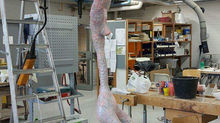'Njassa'
Little ‘Njassa’ Created as a gift for Jyrki Jantunen (Njassa) following a radio interview in Helsinki, this sculpture incorporates a juice bottle and a light bulb. The bottle’s form naturally follows the silhouette of the subject, while the illuminated bulb serves as the head, activating the sculpture as a lamp. Though the depiction of his iconic bomber jacket was an approximation, the work captures the essence of the individual and reflects my exploration of personal homage


'Cash-catcher'
(Installation) Dimensions: 13560 x 9960 Materials: wood, hangers, paint, rope Exhibited: Kamppi Trade Center, Helsinki, 2017 Created for the ‘Media Intervention in the City’ course at Aalto University, this installation addresses consumerism and its pervasive influence. The structure, reminiscent of a spider, draws visitors upward in a commercial space, ultimately consuming their attention and energy, analogous to the extraction of vitality. The segmented ‘legs’ of the spider


'Plain X'
Dimensions: 243 x 103 Materials: welded wire, metal net, papier-mâché, acrylics A suspended sculpture/lamp of an extra-terrestrial woman, made of welded metal wire, wrapped in metal net, and covered in papier-mâché with an acrylic finish. The sculpture embodies a puppet-like figure suspended from the ceiling, yet its rigid, provocative posture contrasts with the inherent softness of a puppet, creating tension and ambiguity. The downward gaze and slightly submissive stance e


'Draco'
Dimensions: 160 x 130 x 50 Materials: wood, papier-mâché, light bulb, acrylics This dragon-shaped lamp, constructed on a wooden branch and incorporating papier-mâché, acrylics, and an umbrella, merges myth with domestic functionality. The organic curves of the branch define the dragon’s posture, creating a natural equilibrium and architectural harmony. The light bulb positioned within the dragon’s mouth symbolises vitality and desire. Traditionally, dragons juxtapose beauty a


'Haliurunnae'
Dimensions: 65 x 47 x 31’’ Materials: Paper pulp, acrylics The sculpture draws on the legend of the Haliurunnae, women accused of witchcraft in Gothic tradition. Built upon a wooden branch, the figure depicts a woman tied to a tree, stripped of clothing, and poised for a ritualistic act. The red hair signifies witchcraft and transgressive power, while her relaxed posture and serene expression challenge conventional associations of sin with remorse. The work references Norse s















































